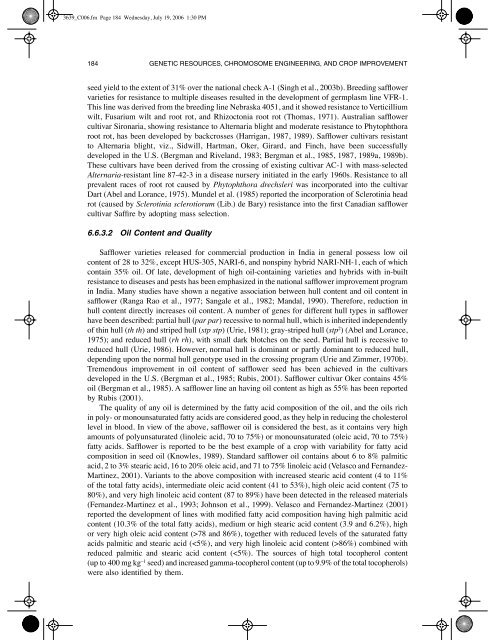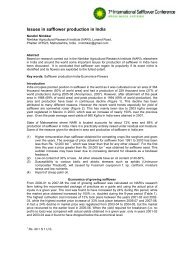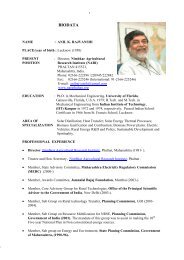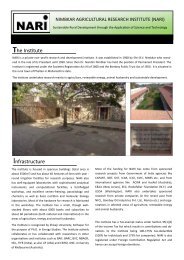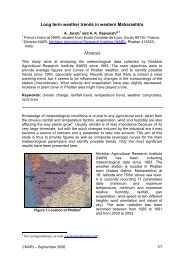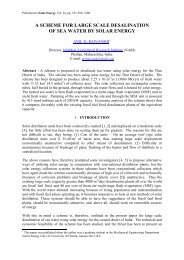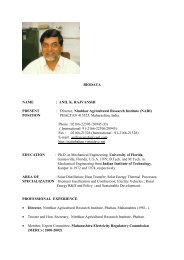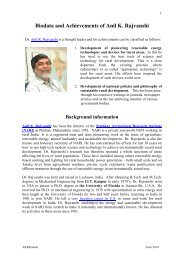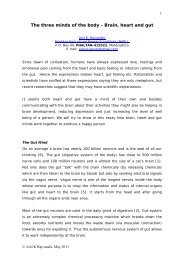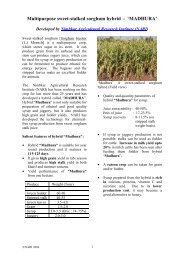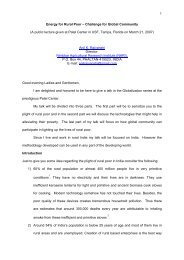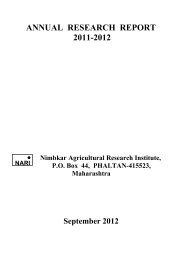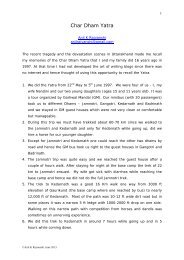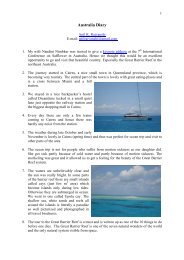Safflower (Carthamus tinctorius L.) - NARI
Safflower (Carthamus tinctorius L.) - NARI
Safflower (Carthamus tinctorius L.) - NARI
You also want an ePaper? Increase the reach of your titles
YUMPU automatically turns print PDFs into web optimized ePapers that Google loves.
3639_C006.fm Page 184 Wednesday, July 19, 2006 1:30 PM184 GENETIC RESOURCES, CHROMOSOME ENGINEERING, AND CROP IMPROVEMENTseed yield to the extent of 31% over the national check A-1 (Singh et al., 2003b). Breeding safflowervarieties for resistance to multiple diseases resulted in the development of germplasm line VFR-1.This line was derived from the breeding line Nebraska 4051, and it showed resistance to Verticilliumwilt, Fusarium wilt and root rot, and Rhizoctonia root rot (Thomas, 1971). Australian safflowercultivar Sironaria, showing resistance to Alternaria blight and moderate resistance to Phytophthoraroot rot, has been developed by backcrosses (Harrigan, 1987, 1989). <strong>Safflower</strong> cultivars resistantto Alternaria blight, viz., Sidwill, Hartman, Oker, Girard, and Finch, have been successfullydeveloped in the U.S. (Bergman and Riveland, 1983; Bergman et al., 1985, 1987, 1989a, 1989b).These cultivars have been derived from the crossing of existing cultivar AC-1 with mass-selectedAlternaria-resistant line 87-42-3 in a disease nursery initiated in the early 1960s. Resistance to allprevalent races of root rot caused by Phytophthora drechsleri was incorporated into the cultivarDart (Abel and Lorance, 1975). Mundel et al. (1985) reported the incorporation of Sclerotinia headrot (caused by Sclerotinia sclerotiorum (Lib.) de Bary) resistance into the first Canadian safflowercultivar Saffire by adopting mass selection.6.6.3.2 Oil Content and Quality<strong>Safflower</strong> varieties released for commercial production in India in general possess low oilcontent of 28 to 32%, except HUS-305, <strong>NARI</strong>-6, and nonspiny hybrid <strong>NARI</strong>-NH-1, each of whichcontain 35% oil. Of late, development of high oil-containing varieties and hybrids with in-builtresistance to diseases and pests has been emphasized in the national safflower improvement programin India. Many studies have shown a negative association between hull content and oil content insafflower (Ranga Rao et al., 1977; Sangale et al., 1982; Mandal, 1990). Therefore, reduction inhull content directly increases oil content. A number of genes for different hull types in safflowerhave been described: partial hull (par par) recessive to normal hull, which is inherited independentlyof thin hull (th th) and striped hull (stp stp) (Urie, 1981); gray-striped hull (stp 2 ) (Abel and Lorance,1975); and reduced hull (rh rh), with small dark blotches on the seed. Partial hull is recessive toreduced hull (Urie, 1986). However, normal hull is dominant or partly dominant to reduced hull,depending upon the normal hull genotype used in the crossing program (Urie and Zimmer, 1970b).Tremendous improvement in oil content of safflower seed has been achieved in the cultivarsdeveloped in the U.S. (Bergman et al., 1985; Rubis, 2001). <strong>Safflower</strong> cultivar Oker contains 45%oil (Bergman et al., 1985). A safflower line an having oil content as high as 55% has been reportedby Rubis (2001).The quality of any oil is determined by the fatty acid composition of the oil, and the oils richin poly- or monounsaturated fatty acids are considered good, as they help in reducing the cholesterollevel in blood. In view of the above, safflower oil is considered the best, as it contains very highamounts of polyunsaturated (linoleic acid, 70 to 75%) or monounsaturated (oleic acid, 70 to 75%)fatty acids. <strong>Safflower</strong> is reported to be the best example of a crop with variability for fatty acidcomposition in seed oil (Knowles, 1989). Standard safflower oil contains about 6 to 8% palmiticacid, 2 to 3% stearic acid, 16 to 20% oleic acid, and 71 to 75% linoleic acid (Velasco and Fernandez-Martinez, 2001). Variants to the above composition with increased stearic acid content (4 to 11%of the total fatty acids), intermediate oleic acid content (41 to 53%), high oleic acid content (75 to80%), and very high linoleic acid content (87 to 89%) have been detected in the released materials(Fernandez-Martinez et al., 1993; Johnson et al., 1999). Velasco and Fernandez-Martinez (2001)reported the development of lines with modified fatty acid composition having high palmitic acidcontent (10.3% of the total fatty acids), medium or high stearic acid content (3.9 and 6.2%), highor very high oleic acid content (>78 and 86%), together with reduced levels of the saturated fattyacids palmitic and stearic acid (86%) combined withreduced palmitic and stearic acid content (


